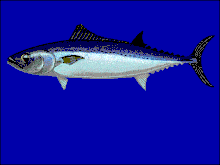Slender tuna
| Slender tuna | |
|---|---|

| |
| Scientific classification | |
| Domain: | Eukaryota |
| Kingdom: | Animalia |
| Phylum: | Chordata |
| Class: | Actinopterygii |
| Order: | Scombriformes |
| Family: | Scombridae |
| Subfamily: | Scombrinae |
| Tribe: | Thunnini |
| Genus: | Allothunnus |
| Species: | A. fallai
|
| Binomial name | |
| Allothunnus fallai Serventy,1948
| |
| Synonyms[2] | |
|
Gasterochisma fallai(Serventy, 1948) | |
Theslender tuna,Allothunnus fallai,is a species oftuna,the only species in the genusAllothunnus,found around the world in the southern oceans between latitudes20°and50° South,although there are two records of probablevagrants,one inLos Angeles Harbourand the other from the North Pacific subarcticgyre.[1]It has a more elongated body than other species of tuna with which it issymaptricsuch as thealbacoreThe colour is blue-black on the back with silvery greyish-white sides, however some individuals have a coppery sheen soon after capture. It has a small seconddorsalandanal finsresembling a small albacore, but the slender tuna lacks the long sweeping pectoral fins characteristic of albacores.[3]Thepectoral finsandpelvic finsare purple on their distal portions and black near their bases.[4]Its length is up to 1 metre (3.3 ft)[2]and it can weigh up to 12 kilograms (26 lb).[3]It occasionally forms schools and its main prey iskrillbut it is also known to prey onsquidand smaller fishes,[2]such asjack mackerel.[5]It is a species of minor commercial importance, taken mainly asbycatchby fisheries for other tuna species.[1]It has rather oily flesh, paler than that of other tuna, but the flesh is palatable when cooked,[2]although it is suitable forcanning.[4]The high oil content of the flesh is caused by the oily nature of its diet and varies over the tuna's life, fish which have just fed are high in oil but specimens caught at the end of their migrations will have relatively low oil content. The high concentration ofOmega -3 polyunsaturated fatty acidsin the flesh of this species caused theCSIROto declare that the slender tuna was Australia's healthiest seafood dish.[5]
References
[edit]- ^abcCollette, B.; Amorim, A.F.; Boustany, A.; et al. (2011)."Allothunnus fallai".The IUCN Red List of Threatened Species.2011:e.T170349A6761139.doi:10.2305/IUCN.UK.2011-2.RLTS.T170349A6761139.en.
- ^abcdFroese, Rainer;Pauly, Daniel (eds.)."Allothunnus fallai".FishBase.February 2018 version.
- ^abGary Wilson (2 April 2017). Alan Burgess (ed.)."Slender Tuna –Allothunnus fallai".New Zealand Sea Fishes.fishingmag.co.nz.Retrieved7 May2018.
- ^abDianne J. Bray; S. Schultz (eds.)."Slender Tuna,Allothunnus fallaiServenty 1948 ".Fishes of Australia.Museums Victoria.Retrieved7 May2018.
- ^abAndrew Darby (14 May 2002)."Slender tuna surfaces with the good oil".The Age.Retrieved7 May2018.
- Tony Ayling & Geoffrey Cox,Collins Guide to the Sea Fishes of New Zealand,(William Collins Publishers Ltd, Auckland, New Zealand 1982)ISBN0-00-216987-8
External links
[edit]- "Allothunnus fallai".Integrated Taxonomic Information System.Retrieved6 September2024.
- Froese, Rainer;Pauly, Daniel (eds.)."Allothunnus fallai".FishBase.Retrieved6 September2024.


